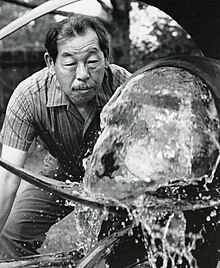George Tsutakawa
| George Tsutakawa | |
|---|---|
 |
|
| Born |
February 22, 1910 Seattle, Washington |
| Died | December 18, 1997 (aged 87) Seattle |
| Nationality | American |
| Education | MFA, University of Washington |
| Known for | Painter, sculptor |
| Movement | Northwest School |
| Awards | Order of the Rising Sun; honorary doctorates |
George Tsutakawa (February 22, 1910 – December 18, 1997) was an American painter and sculptor best known for his avant-garde bronze fountain designs.
Born in Seattle, Washington, he was raised in both the United States and Japan. He attended the University of Washington, where, after serving in the U.S. Army during World War Two, he became a teacher. He rose to international prominence as a fountain designer in the 1960s and 1970s. During his long career more than 70 of his distinctive fountains - many of them still extant - were placed in public spaces.
He is often associated with the progressive 'Northwest School' of artists, and is among the major, influential figures of modern Asian-American art.
He died in Seattle in 1997.
George Tsutakawa was born February 22, 1910, in Seattle, Washington. He was named in honor of George Washington (whose birthday is Feb. 22nd). His parents, Shozo and Hisa, were both born in Japan. He was the fourth of nine children, all of whom, except for his eldest sister, were born in the U.S.. George's father and two uncles ran a successful import-export business, Tsutakawa Company, shipping mainly lumber and scrap metal to Japan, and general goods from Japan to the U.S.
George moved to his mother's hometown of Fukuyama, Japan, at age seven, along with his siblings, while his father remained in Seattle. His mother died of influenza in 1918; his father remarried.
The family lived with their maternal grandmother. As a big, dairy-fed American kid who spoke very little Japanese, George had trouble fitting in, and found comfort in art. His grandparents introduced him to traditional Japanese art forms such as Kabuki and Noh drama, Sumi-e painting, calligraphy, wood-block printing, ceramics, flower arranging, and the tea ceremony; at the same time, he studied European and American art, and developed a lifelong love of Western classical music. He showed promise as an artist, but to his father's disappointment he was a mediocre student with little interest in joining the family business.
After finishing high school and brief service as a reservist-trainee in the Japanese Army, Tsutakawa, 16, returned to the U.S. Now a Japanese-speaker, he enrolled in Seattle's Broadway High School, where he re-learned English and studied art, falling in with a group of progressive-minded young artists which included Morris Graves, Andrew Chinn, and Fay Chong. He also visited and informally studied with Kamekichi Tokita, Kenjiro Nomura, and other older artists from Seattle's vibrant Asian-American arts community.
...
Wikipedia
